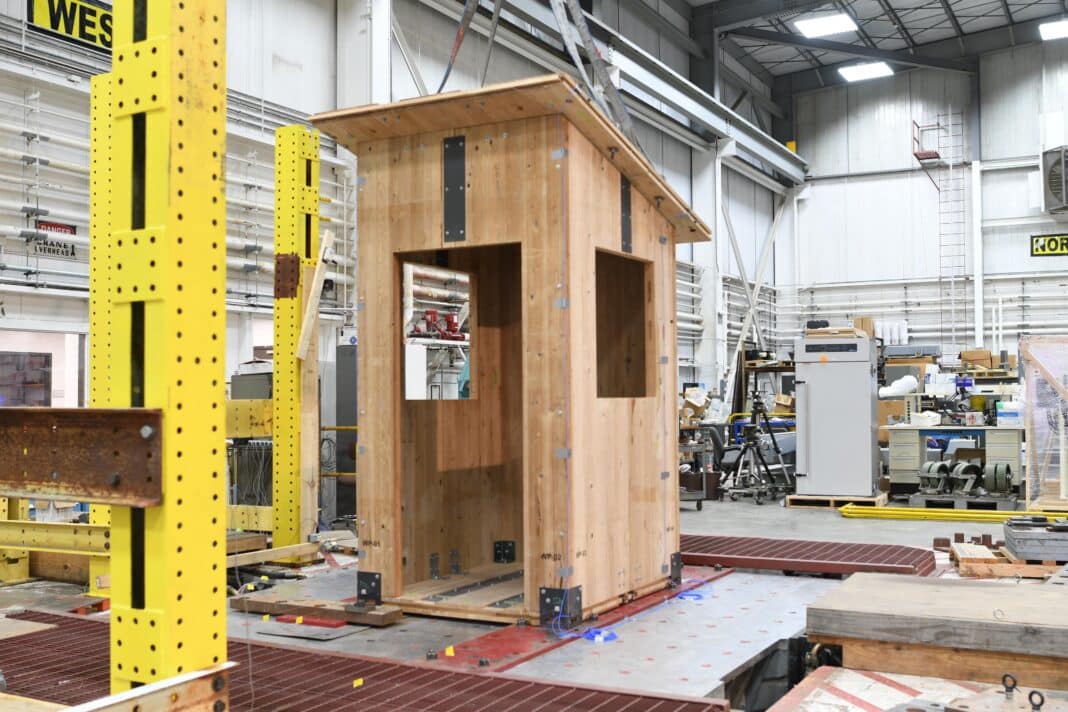The US Army is working with material scientists on new cross-laminated timber technology to scale up mass timber usage in civilian housing projects and counter-terrorism and force protection projects.
If successful, the US Army will use mass timber and waste repurposed from the aerospace industry to produce new prefabricated “biologically resilient structures,” which can be easily disassembled and reassembled in new locations.
It comes after the US Army Engineer Research and Development Center (or ERDC) introduced a “first of its kind Construction Policy” ensuring that “a mass timber structural option be considered at the design phase in all of its vertical construction projects going forward.”
Partnering with the Composite Recycling Technology Center (CRTC), the US Army is working with the University of Washington and Washington State University to model a new thermal modification process called Advanced Cross Laminated Timber (ACLT).
If successful, the US Army will scale up the production of mass timber solutions from highly accessible (and economical) Western Hemlock, a tree species common in the Pacific Northwest, working with indigenous tribes to harvest, process and supply the timber.
“Mass timber has a lot of momentum in the Army right now,” according to Dr Pete Stynoski, a research civil engineer at ERDC, adding that the project is trying to “widen sourcing Class IV materials for more resilient structures in everyday use and contested logistics scenarios.”
For more than 20 Years, Dr Stynski and the ERDC have been researching the use of mass and cross-laminated timber in US Military Construction Projects (or MILCON).
However, until now, mass timber has only been considered in low-rise projects (up to three levels) due to cost and supply considerations.
In the policy released last year, the ERDC acknowledged that “in certain CONUS (a US Department of Defence term to identify the states of USA) regions, mass timber may not be widely competitive at this time.”
But this could change after US Congress directed the US Army to study how ACLT could be used to “develop a highly durable, quick-erect building panel system for military housing.”
The market for MILCON is enormous, with Congress, in September, approving more than US $16.674 billion in spending – split between military construction ($14.73 billion) and military housing ($1.94 billion), with more than US $1.47 billion in spending allocated for the US Army Corps of Engineers (which oversees the ERDC).
Now, the ERDC, with the help of force protection and building technology expertise, is testing the new material for fragment impact and seismic simulations at its state-of-the-art testing facilities in Washington State.
“One of the ultimate goals (of the research) is to produce smaller-scale contingency-style structures that can be disassembled, put into a container and moved to another place,” Dr Stynoski said.
“Maybe there is a pre-positioned stock of these materials where we might need them,” he said before adding, “Because of that thermal modification, it is resilient against biological threats. It is extremely dimensionally stable; it doesn’t have moisture expansion and contraction issues.”
According to CRTC CEO David Walter, the project “ticks a lot of boxes”, adding that “we (CRTC) are extremely excited that this project allows us the opportunity to not only provide environmental and economic benefits but also to provide a major social benefit to a disadvantaged area.”
CRTC is a non-profit corporation that designs, develops and manufactures products that recycle carbon fibre scrap. Its process for ACLT centres on using composite reinforcements repurposed from aerospace industry waste. The project partners also include the Makah Tribe in Neah Bay, Washington, who will build a sawmill and supply the timber for the Army.
For Dr Stynoski, choosing mass timber construction over steel and concrete is not just an environmental consideration but also increases logistical flexibility where forests are abundant.
“There are certain parts of the world where this is another arrow in the quiver … where mass timber will be fastest to construct,” Dr Stynoski stated, adding that thermally modified structural timber “offers great potential to the military” because “its dimensional stability during long-term storage is superior to traditional lumber, which expands and contracts over time.”
According to Dr Robert Moster, ERDC’s Senior Scientific Technical Manager for Materials, Manufacturing and Structures, the project in the pilot phase could pave the way for new industries and markets for previously underused timber resources.
As mass timber becomes more accessible, Dr Moster said, transportation burdens will decrease, increasing the material’s environmental and economic benefits.
“These efforts can develop new markets and industries in these communities for products that don’t have a market right now,” Dr Moster said. “That could be in the Pacific Northwest, or it could result from taking lessons from this project and applying them elsewhere to fortify lower-quality timber and build it into higher-performance structural material. I think this has the potential to build up new markets.”
He said “(the US Army is already) further advancing its long-standing efforts in high-performance and sustainable buildings with a focus on low embodied carbon construction materials,” which Dr Moser said has a “strong emphasis on bio-based building materials like mass timber.”
The US Department of Defence is at the forefront of the push to utilise low-carbon materials like mass timber and zero-carbon concrete to decarbonise military activities.
In 2021, the department published a groundbreaking report on using mass timber products in military construction projects.
The report highlighted its potential uses for on-base and Forward Operating Base/Contingency Operating Base Facilities operations and supported blast tests in 2016 and 2017 to test durability under heavy fire.
It found that cross-laminated timber’s “sweet spot” is mid to high-rise buildings, “where it competes with heavier steel and concrete”. Still, it acknowledged that light-gauge metal stud construction is advantageous in low-rise military bases “due to its load capacity limitations.”






